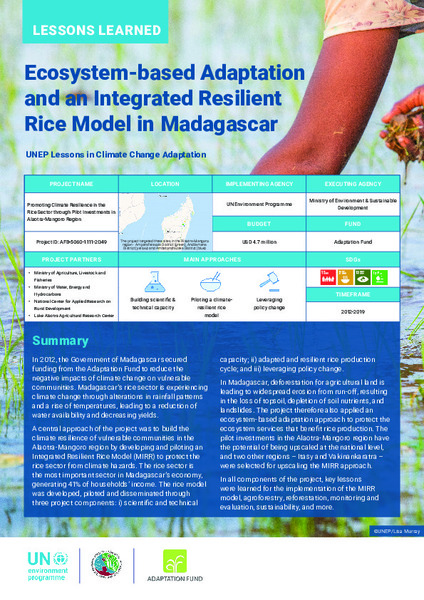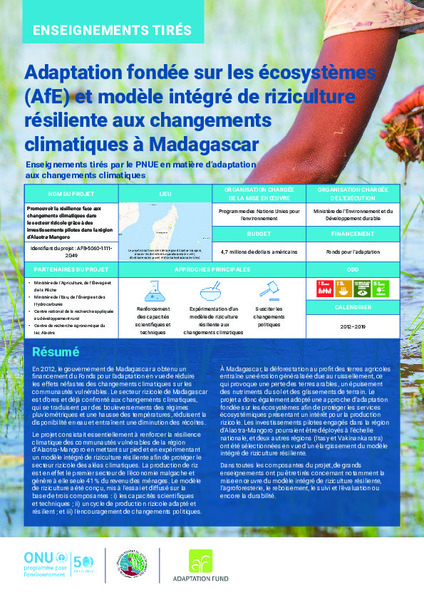| dc.contributor | Ecosystems Division | en_US |
| dc.contributor.author | United Nations Environment Programme | en_US |
| dc.coverage.spatial | Madagascar | en_US |
| dc.date.accessioned | 2022-07-14T08:28:08Z | |
| dc.date.available | 2022-07-14T08:28:08Z | |
| dc.date.issued | 2022-07 | |
| dc.identifier.uri | https://wedocs.unep.org/20.500.11822/40368 | |
| dc.description | In Madagascar, deforestation for agricultural land is leading to widespread erosion from run-off, resulting in the loss of topsoil, depletion of soil nutrients, and landslides. The project therefore also applied an ecosystem-based adaptation approach to protect the ecosystem services that benefit rice production. The pilot investments in the Alaotra-Mangoro region have the potential of being upscaled at the national level, and two other regions – Itasy and Vakinankaratra – were selected for upscaling the MIRR approach. In all components of the project, key lessons were learned for the implementation of the Integrated Resilient Rice Model (MIRR), agroforestry, reforestation, monitoring and evaluation, sustainability, and more. | en_US |
| dc.format | Text | en_US |
| dc.language | English | en_US |
| dc.language | Portuguese | |
| dc.rights | Public | en_US |
| dc.subject | climate change | en_US |
| dc.subject | rice | en_US |
| dc.subject | Madagascar | en_US |
| dc.subject | reforestation | en_US |
| dc.subject | climate change adaptation | en_US |
| dc.subject | capacity building | en_US |
| dc.title | Ecosystem-based Adaptation and an Integrated Resilient Rice Model in Madagascar - UNEP Lessons in Climate Change Adaptation | en_US |
| dc.title.alternative | Adaptação baseada em ecossistemas e um modelo integrado de rizicultura resiliente em Madagascar - Lições do PNUMA sobre adaptação às mudanças climáticas | |
| wd.identifier.sdg | SDG 1 - No Poverty | en_US |
| wd.identifier.sdg | SDG 2 - Zero Hunger | en_US |
| wd.identifier.sdg | SDG 13 - Climate Action | en_US |
| wd.identifier.sdg | SDG 15 - Life on Land | en_US |
| wd.topics | Climate Action | en_US |
| wd.topics | Nature Action | en_US |
| wd.identifier.pagesnumber | 7 pages | en_US |




